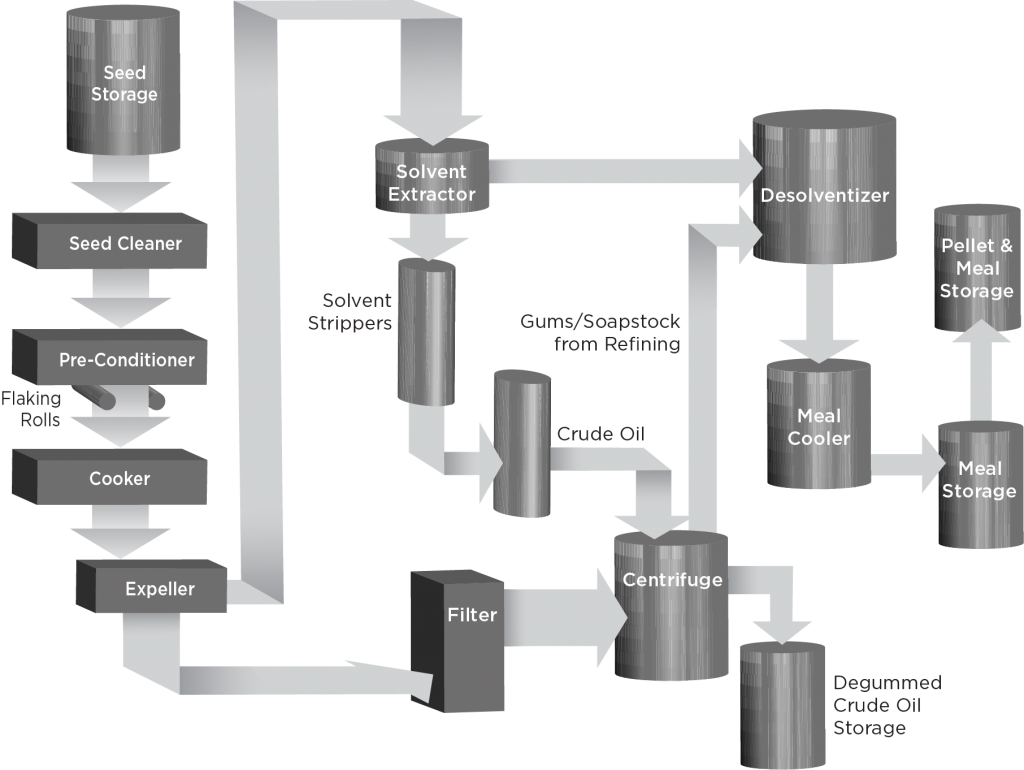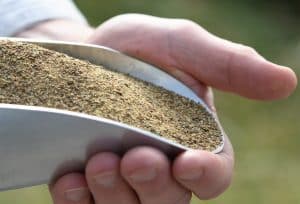How Much Canola to Make a Litre of Oil
How canola seed becomes oil and meal products
The process for turning canola seed into oil and meal is similar to how other oilseeds are processed. Seed is preconditioned and pressed to separate the oil from the solids. Further refining and processing create finished canola products, ready for the market or further processing.
Learn more about:
Traditional processing
Most Canadian companies use the same method to process canola seed.
Cleaning
First canola seed is thoroughly cleaned to remove "dockage" – weed seeds, stems, pods and other materials that may be picked up as canola is harvested.
Heating and flaking
Canola is heated and flaked before extraction so more oil can be released. The temperature is slightly raised in grain dryers to prevent shattering. The seed is then passed through rollers to gently rupture the cell walls and flake the seed to just the right thickness.
Seed cooking
Next the flakes go through a series of heating drums or stack-type cookers. This ruptures more cells and optimizes the viscosity of the oil and moisture of the flakes for the processes ahead. Cooking also prevents the breakdown of products that could affect quality.

Pressing
The cooked flakes then go through a series of screw presses or expellers for a mild pressing. This process removes most of the oil and compresses the rest of seed into cake.
Solvent extraction
To remove the remaining oil, the presscake is put into an extractor and saturated with a solvent called hexane. The solvent percolates through the cake and carries nearly all of the remaining oil away. The hexane is then removed from the oil and solids, reused and recycled.
Further oil refining and processing
Crude canola oil is further refined to improve colour, flavour and shelf life. Water and organic acids may be used to remove lipids, gums, free fatty acids and fine meal particles. Color pigments are removed by passing oil through a filter containing natural clay (a process sometimes called "bleaching," although no bleach is used). The final step is to remove any unpleasant odours or compounds with steam distillation.
At this point, canola oil is ready to be packaged and sold as cooking oil, or further processed into a wide range of consumer and commercial products.
Meal processing
After the oil has been removed, the remaining solids are processed into canola meal, a protein source used in animal feed. The meal is placed on heated plates and injected with live steam – a process called toasting – to remove the remaining solvent. After it has been cooled, dried and granulated, the meal may be pelleted or sent directly to storage as a mash.

Quality assurance
Throughout canola processing, temperature and other factors must be carefully controlled to ensure quality.
During seed cooking and meal toasting, temperature must be raised rapidly to destroy an enzyme. However, if temperatures are too high for too long, protein can be damaged.
At Canadian processing plants, experience and consistent conditions help to ensure quality. View a map of canola processing plants across Canada or learn more about the expansion of domestic processing capacity.
Alternative processes
A small proportion of Canadian canola is processed without solvent extraction and in some cases also without the use of heat.
Double press or expeller press
In this process, canola seed is pressed a second time to extract oil without using solvents. Up to that point, the preconditioning process may be the same as for traditional processing. The resulting meal has higher oil content, and therefore provides more energy.
Cold press
In cold-pressing, seed is not heated before, during or after the pressing process. The oil is extracted through mechanical means only. Seed is pressed slowly to limit friction and avoid elevating temperatures. Canola oil produced by these methods has a stronger colour, taste and odour and similar to the expeller press, the meal contains a high oil content.
How Much Canola to Make a Litre of Oil
Source: https://www.canolacouncil.org/about-canola/processing/